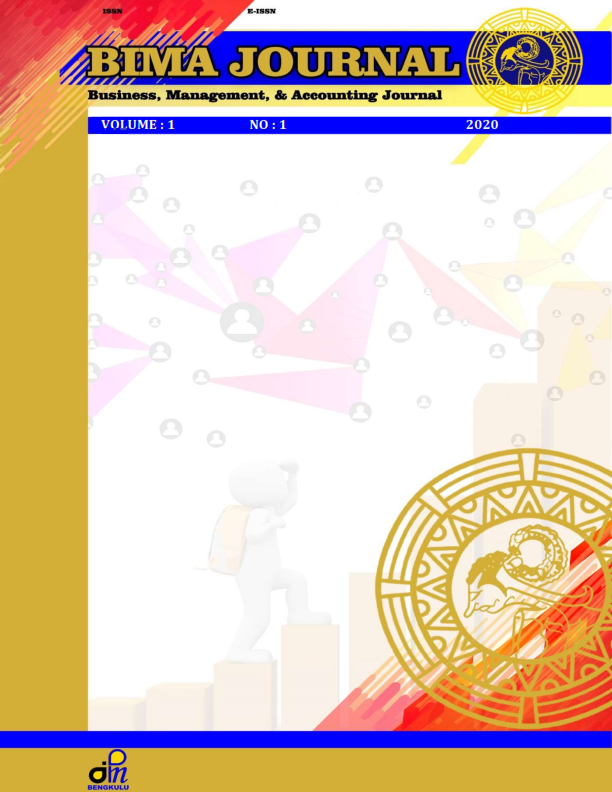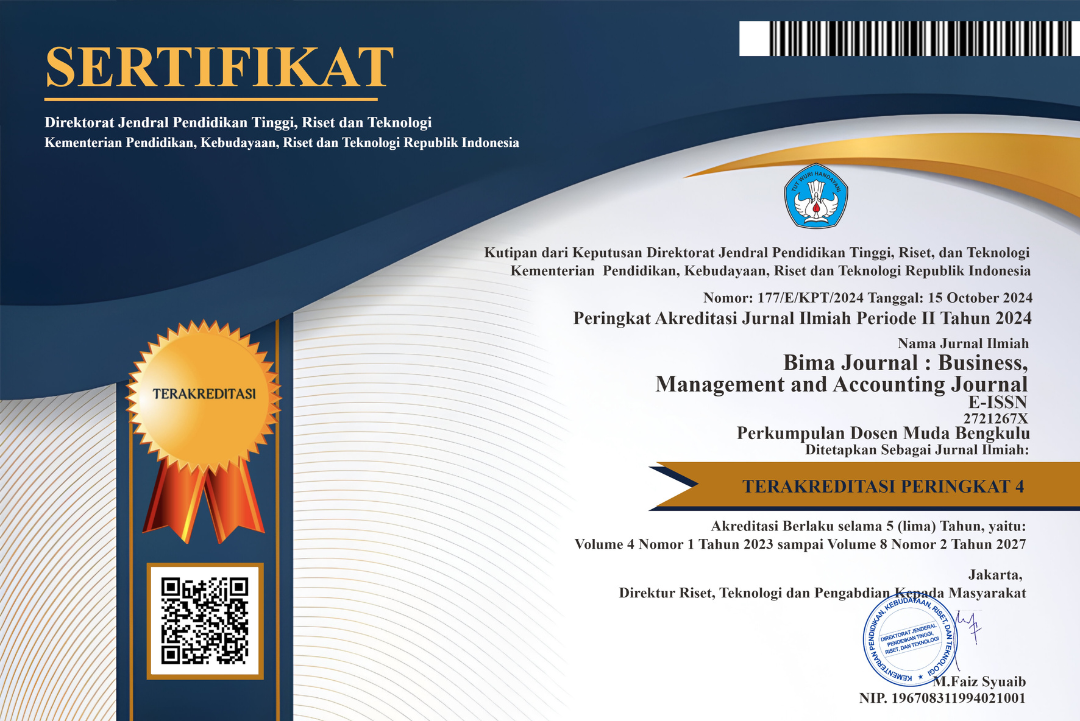OPTIMIZATION OF KOTO JAYA DAILY MARKET PRODUCTION IN MUKOMUKO
DOI:
https://doi.org/10.37638/bima.1.1.10-21Abstract
This study aims to identify internal and external factors faced by the Koto Jaya Daily Market in Mukomuko, determine the optimization strategy of the market utilization. The data used in this study are primary data obtained from traders at the Koto Jaya Daily Market in Mukomuko in 2018 using a SWOT analysis tool.
The results of the SWOT analysis can be concluded that internal factors in optimizing the utilization of the Koto Jaya Daily Market in Mukomuko are; 1) Strength Factors (land availability, location, supporting facilities, trader organizations, merchant composition, infrastructure, price information); 2) Weakness factors (rental prices, utilities, location access, market conditions, budget constraints, trader awareness), for external factors in optimizing the utilization of the Koto Jaya Daily Market in Mukomuko are; 1) Opportunity factors (population, community response, government support, technological development); 2) Threat factors (other market competitors, natural disasters, thuggery, government policies, economic crisis). The strategy that must be applied in this condition is the WT (Weaknesses-Threats) strategy, namely; 1) Implement a kiosk and booth rental price strategy; 2) Improve the quality and service quality of the Koto Jaya Mukomuko Market; 3) Optimizing existing facilities and infrastructure; 4) Maintain market security and comfortReferences
Arsyad, L. 2000. Ekonomi Manajerial. BPFE. Yogyakarta.
Badan Pusat Statistik Kabupaten Mukomuko. 2011. Mukomuko Dalam Angka 2011. BPS Mukomuko
Blair, Jhon P. 1995. Local Economic Development, Analysis and Practice. California, USA: Sage Publications Inc.
Budiarto, Andreas. 2011. Analisis Sistem Perawatan Aset Operasional Medis RS. Panti Rapih Yogyakarta. Tesis S-2. Program Studi Magister Ekonomika Pembangunan, Fakultas Ekonomika dan Bisnis. Universitas Gadjah Mada. Yogyakarta. Tidak dipublikasikan.
Campbell, R. Mc Conned and Stanley L brue. 1990. Economic, Problem and Policie. Mc Graw Publishing Company.
Daldjoeni, Nathaniel. 1997. Geografi Baru Organisasi Keruangan Dalam Teori dan Praktek. Penerbit Alumni. Bandung.
Damsar. 1997. Sosiologi Ekonomi. Penerbit PT. Raja Grafindo Persada Jakarta.
David, R. 2004. Manajemen Strategis. PT. Prenhallindo. Jakarta.
De Chiara, Joseph dan E Lee Koppelman. 1997. Standar Perencanaan Tapak. Penerbit PT. Erlangga. Jakarta.
Dewar, David and Vanessa Watson.1990. Urban Market Developing Informal Retailing. London: Rontledge.
Dinas Perindustrian, Perdagangan dan Koperasi, 2012. Laporan Aset. Pemerintah Kabupaten Mukomuko.
Djojodipuro, Marsudi. 1992. Teori Lokasi. Lembaga Penerbit Fakultas Ekonomi Universitas Indonesia. Jakarta.
Galion, Arthur and Simon Eisner. 1994. The Urban Pattern, 3rd Edition. New York.
Gallion, A.B dan Simon Eisner, 1996, Pengantar Perancangan Kota, Jilid I, Terjemahan Susongko dan Januar Hakim. Jakarta: Galia Indonesia.
Gibson, James L., et.al., terjemahan Nunuk Adiarni, 1996, Organisasi: Perilaku, Struktur-Proses,. Edisi ke delapan, Jakarta: Binarupa Aksara.
Harian Bengkulu Express. Senin 5 November 2012
Harian Radar Mukomuko. Senin 25 Februari 2013
Herlambang, T. 2002. Ekonomi Manejerial dan Strategi Bersaing. PT. Raja Grafindo Persada. Jakarta.
Istiningtyas, Arum Dyah. 2008. Analisis kebijakan dan strategi Pengembangan Pasar Tradisional Di Kota Bogor. Skripsi. Institut Pertanian Bogor.
Keputusan Menteri Pekerjaan Umum Nomor: 378/KPTS/1987 Tentang Pengesahan 33 Standar Konstruksi Bangunan Indonesia.
Keputusan Menteri Perindustrian dan Perdagangan Nomor: 23/MPP/KEP/1/1998 Tentang Lembaga-lembaga Usaha Dagang Perdagangan.
Kinnear, Thomas C. and James R. Taylor. 1995. Marketing Research: An Applied Approach. McGraw Hill Text.
Kotler, Philip and Donald H Hauder, Irving Rein. 1998. Marketing Places: Attracting Investment, Industry and Tourism To Cities, States and Nations. The Free Press Adivission of Macmillan Inc. New York.
Kotler, Philip dan Gary Armstrong. 2001. Prinsip-Prinsip Pemasaran, Erlangga. Jakarta.
Kotler, Philip dan Gary Armstrong. 2008. Prinsip-Prinsip Pemasaran, Erlangga. Jakarta.
Mankiw, N. G. 2000. Pengantar Ekonomi Jilid I. Erlangga. Jakarta.
Mariana dan Paskarina. 2006.”Menggagas Model Revitalisasi Pasar Tradisional: Studi Terhadap Implementasi Perda No.19 Tahun 2001 Tentang Pengelolaan Pasar Kota Bandung”. Puslit KP2W Lemlit UNPAD, Bandung.
Millers, Roger Le Roy and Meiners, Roger. E. 2000. Teori Mikroekonomi Intermediate. Edisi Keempat. PT. Raja Grafindo. Jakarta.
Mursid, M. 1997. Manajemen Pemasaran. Penerbit: Bumi Aksara. Jakarta.
Nicholson, W. 2002. Intermediate Microeconomics and Its Application. Eight Edition. Harcount, Inc. New York.
Rangkuti, Freddy, 2001, Analisis SWOT Teknik Membedah Kasus Bisnis. Jakarta: Penerbit PT Gramedia Pustaka Utama.
Rangkuti, Freddy. 2006. Analisis SWOT Teknik Membedah Kasus Bisnis. Jakarta: Penerbit PT Gramedia Pustaka Utama.
Ristyanto, Yanuar. 2004. Evaluasi Alternatif Lokasi Pasar Induk Sayur Di Kota Surabaya, Tugas Akhir Tidak Diterbitkan. Teknik Perencanaan Wilayah dan Kota. Universitas Diponegoro. Semarang.
Samuelson, P. A dan W. D. Nordhaus. 2001. Ilmu Ekonomi. PT. Media Global Edukasi. Jakarta.
Sevilla, Consuelo et. Al. 1993. Pengantar Metode Penelitian. Terjemahan Alimuddin Tuwu. Universitas Indonesia. Jakarta.
Soesilo, Nining, J. 2000. Ekonomi, Perencanaan dan Manajemen. Universitas Indonesia. Jakarta.
Stanton, William J. 1996. Prinsip Pemasaran. Penerbit: Erlangga. Jakarta.
Sukesih, H. 1994.”Pasar Swalayan dan Prospeknya”. Jurnal Ekonomi dan Pembangunan No.2:63-68.
Sumaatmadja, Nursid. 1998. Studi Geografi, Suatu Pendekatan dan Analisa Keruangan. Penerbit: Alumni. Bandung.
Swastha, Basu DH. 2010. Manajemen Penjualan. Penerbit: BPFE. Yogyakarta.
Syahmora, Abi. 2005. Lokasi Optimal Pembangunan Pasar di Kota Lahat Berdasarkan Kajian Faktor-Faktor Lokasi Penentu Pasar. Thesis. Universitas Diponegoro.
Thompson, Arthur A., Jr., A.J Strickland III, and John E. Gamble. 2008. Crafting and Executing Strategy (The Quest for Competitive Advantage Concepts and Cases). 16th edition. McGraw-Hill.
Tjiptono, Fandy. 2000. Prinsip-Prinsip Total Quality Service. Penerbit: Andi. Yogyakarta.
Tjiptono, Fandy. 2008. Pemasaran Jasa. Penerbit: Bayu Media Publishing. Malang.
Downloads
Additional Files
Published
Issue
Section
License
An author who publishes in the BIMA JOURNAL: Business, Management, and Accounting Journal agrees to the following terms:
Author retains the copyright and grants the journal the right of first publication of the work simultaneously licensed under the Creative Commons Attribution-ShareAlike 4.0 License that allows others to share the work with an acknowledgement of the work's authorship and initial publication in this journal
Submission of a manuscript implies that the submitted work has not been published before (except as part of a thesis or report, or abstract); that it is not under consideration for publication elsewhere; that its publication has been approved by all co-authors. If and when the manuscript is accepted for publication, the author(s) still hold the copyright and retain publishing rights without restrictions. For the new invention, authors are suggested to manage its patent before published. The license type is CC-BY-SA 4.0.
BIMA JOURNAL: Business, Management and Accounting is licensed under a Creative Commons Attribution-ShareAlike 4.0 International License.
You are free to:
Share — copy and redistribute the material in any medium or format
Adapt — remix, transform, and build upon the material
for any purpose, even commercially.
The licensor cannot revoke these freedoms as long as you follow the license terms.
Under the following terms:
Attribution — You must give appropriate credit, provide a link to the license, and indicate if changes were made. You may do so in any reasonable manner, but not in any way that suggests the licensor endorses you or your use.
ShareAlike — If you remix, transform, or build upon the material, you must distribute your contributions under the same license as the original.
- No additional restrictions — You may not apply legal terms or technological measures that legally restrict others from doing anything the license permits.
Notices:
- You do not have to comply with the license for elements of the material in the public domain or where your use is permitted by an applicable exception or limitation.
- No warranties are given. The license may not give you all of the permissions necessary for your intended use. For example, other rights such as publicity, privacy, or moral rights may limit how you use the material.





















